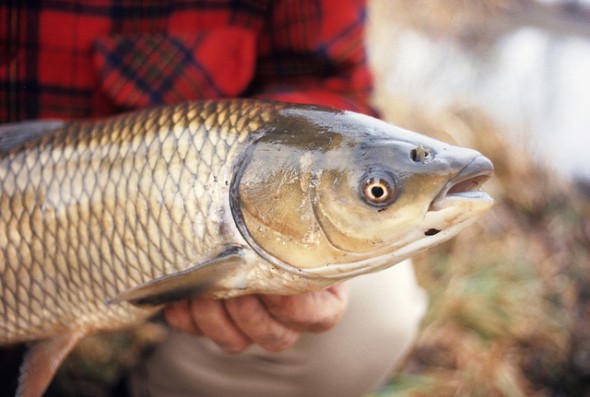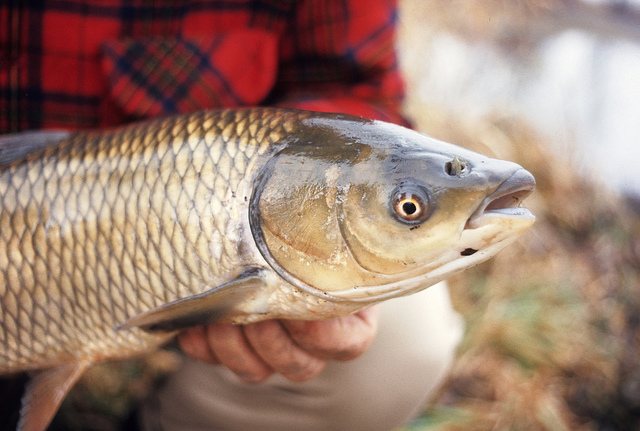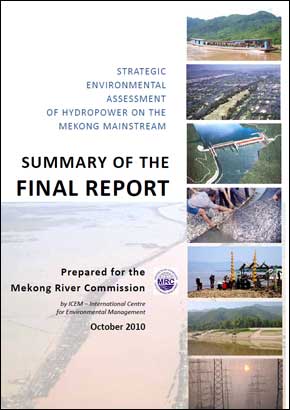Report: Fish Analysis Reveals Asian Carp Have Reproduced in Great Lakes Watershed
A new study shows grass carp reproduced at least once in the Sandusky River, but it cannot confirm an established population.

By Codi Yeager-Kozacek
Circle of Blue
Researchers from the United States Geological Survey (USGS) have determined that four grass carp, caught last fall in Ohio’s Sandusky River, lived their entire lives in the river, suggesting for the first time that the invasive carp have reproduced in the Great Lakes Basin. A study analyzing the origin of the four fish was released Monday.
–Rich Carter, executive administrator
Fish Management & Research, Ohio DNR
The grass carp is just one of four species of Eurasian carp — the others are silver, bighead, and black carp — that have infested the Mississippi River Basin and are threatening to enter the Great Lakes. Unlike the silver and bighead carp, which compete with native fish for their plankton food source, grass carp feed on aquatic vegetation and therefore may not be as much of a threat to the Great Lakes region’s $US 7 billion sport fishing industry.
However, grass carp could destroy habitat for largemouth bass, sun fish, and waterfowl in Lake Erie, according to Rich Carter, executive administrator of fish management and research at the Ohio Department of Natural Resources (ODNR). The federal government has invested more than $US 200 million since 2009 to prevent the spread of Asian carp into the Great Lakes.
“Bighead and silver carp have been moving up the Mississippi River since the late ’70s and early ’80s, and efforts nationally to keep those fish from reaching the Great Lakes are still ongoing and are still very important to maintain,” Carter told Circle of Blue. “It is important to maintain that focus and, at the same time, close knowledge gaps about grass carp and figure out if there’s a responsible path to deal with these fish.”
First (Known) Spawning
The ODNR is actively collaborating with the Asian Carp Coordinating Committee — a coalition of international, national, and regional agencies focused on stopping the spread of Asian carp — to gain a better understanding of where grass carp are in the Great Lakes watershed and how many are reproducing. The recent study only confirms that the grass carp reproduced successfully once within the watershed, not that there is an established population.
–Duane Chapman
U.S. Geological Survey
“We don’t know that the fish are established,” said Duane Chapman, lead author of the USGS study. “Just because they spawned once doesn’t mean they are going to spawn again. This is the first time they’ve spawned that we know of.”
Nonetheless, the prognosis is not good.
“Frankly, these fish are going to be spawning in this river and other rivers around the Great Lakes, and there is a very good chance they are now firmly established,” Chapman told Circle of Blue. “We may be able to control this population over time, but we need to find out where we are. Our biggest goal is to find out — how bad is it?”
Fish Have Sandusky’s “Fingerprint”
The four fish that were analyzed for the study were grass carp, little more than a year old, and were caught by a commercial fisher in the Sandusky River in October 2012. To determine the origin of the fish, USGS scientists looked at their otoliths — bones found in a fish’s head. The otoliths are made up of tiny layers of material that form a record of the water quality conditions in which the fish lived. Water in the Sandusky River has a very unique chemical “fingerprint” containing high levels of strontium, Chapman explained.
“If the lifespan of the fish was maybe 450 days, across 450 days we have 3,500 consecutive measurements of strontium concentrations [in the otolith],” he said. “We know the fish was born there and never left.”
What is less clear is the source of the original spawning population. There are a number of pathways through which the carp could have entered the Sandusky River, including bait fish transfer, live fish markets, and escapes of fertile fish from aquaculture facilities. In Ohio, the sale of sterile grass carp within the aquaculture industry is legally permitted, though a carp capable of reproducing could get through the system either by accident or through illegal sales, according to Chapman.
“One of the things we are planning to do is random testing of Ohio shipments of triploid [sterile] grass carp for fertility status — looking to make sure that what we’re getting is indeed triploid [sterile],” said ODNR’s Carter.
Chapman added that anglers should not transfer live bait between watersheds.
“If you are going to go out and catch your own bait, use the bait where you caught it,” he said.
Regional Implications
The recent findings provide validation for earlier studies which suggested that grass carp — as well as silver and bighead carp — could reproduce successfully in more Great Lakes tributaries than previously thought. The Sandusky River, for example, was thought to be too short to support Asian carp spawning, but a study published this summer predicted that carp eggs could survive and hatch while flowing along just 14 kilometers (8.5 miles) of the river.
“We know so much more about these fish than we did 10 years ago, and we’re able to more adequately go in and determine where they are going to spawn, what they are going to do,” Chapman said. “The last 10 years of science have amazingly advanced our knowledge base.”
A news correspondent for Circle of Blue based out of Hawaii. She writes The Stream, Circle of Blue’s daily digest of international water news trends. Her interests include food security, ecology and the Great Lakes.
Contact Codi Kozacek










TALK AND MORE TALK, WHAT ABOUT THE US JUDGE RULING ??